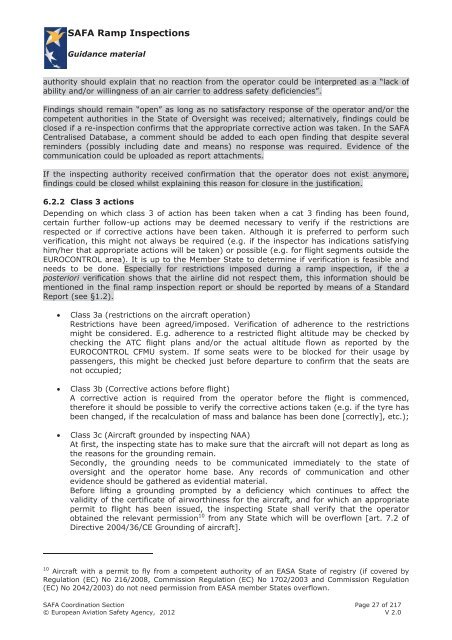SAFA Ramp Inspections - Code7700
SAFA Ramp Inspections - Code7700
SAFA Ramp Inspections - Code7700
You also want an ePaper? Increase the reach of your titles
YUMPU automatically turns print PDFs into web optimized ePapers that Google loves.
<strong>SAFA</strong> <strong>Ramp</strong> <strong>Inspections</strong>Guidance materialauthority should explain that no reaction from the operator could be interpreted as a “lack ofability and/or willingness of an air carrier to address safety deficiencies”.Findings should remain “open” as long as no satisfactory response of the operator and/or thecompetent authorities in the State of Oversight was received; alternatively, findings could beclosed if a re-inspection confirms that the appropriate corrective action was taken. In the <strong>SAFA</strong>Centralised Database, a comment should be added to each open finding that despite severalreminders (possibly including date and means) no response was required. Evidence of thecommunication could be uploaded as report attachments.If the inspecting authority received confirmation that the operator does not exist anymore,findings could be closed whilst explaining this reason for closure in the justification.6.2.2 Class 3 actionsDepending on which class 3 of action has been taken when a cat 3 finding has been found,certain further follow-up actions may be deemed necessary to verify if the restrictions arerespected or if corrective actions have been taken. Although it is preferred to perform suchverification, this might not always be required (e.g. if the inspector has indications satisfyinghim/her that appropriate actions will be taken) or possible (e.g. for flight segments outside theEUROCONTROL area). It is up to the Member State to determine if verification is feasible andneeds to be done. Especially for restrictions imposed during a ramp inspection, if the aposteriori verification shows that the airline did not respect them, this information should bementioned in the final ramp inspection report or should be reported by means of a StandardReport (see §1.2).Class 3a (restrictions on the aircraft operation)Restrictions have been agreed/imposed. Verification of adherence to the restrictionsmight be considered. E.g. adherence to a restricted flight altitude may be checked bychecking the ATC flight plans and/or the actual altitude flown as reported by theEUROCONTROL CFMU system. If some seats were to be blocked for their usage bypassengers, this might be checked just before departure to confirm that the seats arenot occupied;Class 3b (Corrective actions before flight)A corrective action is required from the operator before the flight is commenced,therefore it should be possible to verify the corrective actions taken (e.g. if the tyre hasbeen changed, if the recalculation of mass and balance has been done [correctly], etc.);Class 3c (Aircraft grounded by inspecting NAA)At first, the inspecting state has to make sure that the aircraft will not depart as long asthe reasons for the grounding remain.Secondly, the grounding needs to be communicated immediately to the state ofoversight and the operator home base. Any records of communication and otherevidence should be gathered as evidential material.Before lifting a grounding prompted by a deficiency which continues to affect thevalidity of the certificate of airworthiness for the aircraft, and for which an appropriatepermit to flight has been issued, the inspecting State shall verify that the operatorobtained the relevant permission 10 from any State which will be overflown [art. 7.2 ofDirective 2004/36/CE Grounding of aircraft].10 Aircraft with a permit to fly from a competent authority of an EASA State of registry (if covered byRegulation (EC) No 216/2008, Commission Regulation (EC) No 1702/2003 and Commission Regulation(EC) No 2042/2003) do not need permission from EASA member States overflown.<strong>SAFA</strong> Coordination Section Page 27 of 217© European Aviation Safety Agency, 2012 V 2.0
















